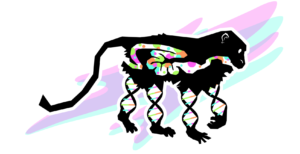At college, I have my own research project that works on the microbiome in macaque monkeys. I personally look at how human influence over diet items can affect the microbiome dynamics of the macaques at different locations. I’ve been working on this for over a year now, so I’m pretty familiar with the microbiome, its metrics, and the focuses…. So I damn near flipped out when this book had a section almost entirely on the microbiome. Granted, it’s a slightly different version and the microbiome isn’t my favorite thing in the world, but Dr. NH and Bowers included a field of study that almost entirely hinges on connecting animals to humans.
While human microbiome research is very well funded (because people like to know about people), microbiome research for other animals or other systems does not get the same consideration. And, microbiology as a field does not have the most stable metrics, so research labs really have to get their stats and significance DOWN. In order to do that, almost everyone links their research to possible human benefits. So yeah, it’s very accurate that this field in particular relies on this inter-species collaboration, and I felt really in-the-know to read about a topic I’m literally contributing to.
That said, the one instance that I knew there was slightly incorrect information in this book was in this section on Firmicutes and Bacteroidetes. Dr. NH says that those are the two dominant groups in the gut microbiome, but that’s not entirely true. In reality, those two groups are in high abundance, but their dominance can fluctuate across species and across ages. Instead, their most valuable asset these phyla offer is the ratio between them (which is alluded to). Still, the value of the F/B Ratio as it’s called is still debated, although it is widely used in research.

(PS the contribution thing was particularly strong when Dr. NH brought up manipulated food items being the main reason for weird human microbiomes made me very happy because it was basically the human version of my own research.)